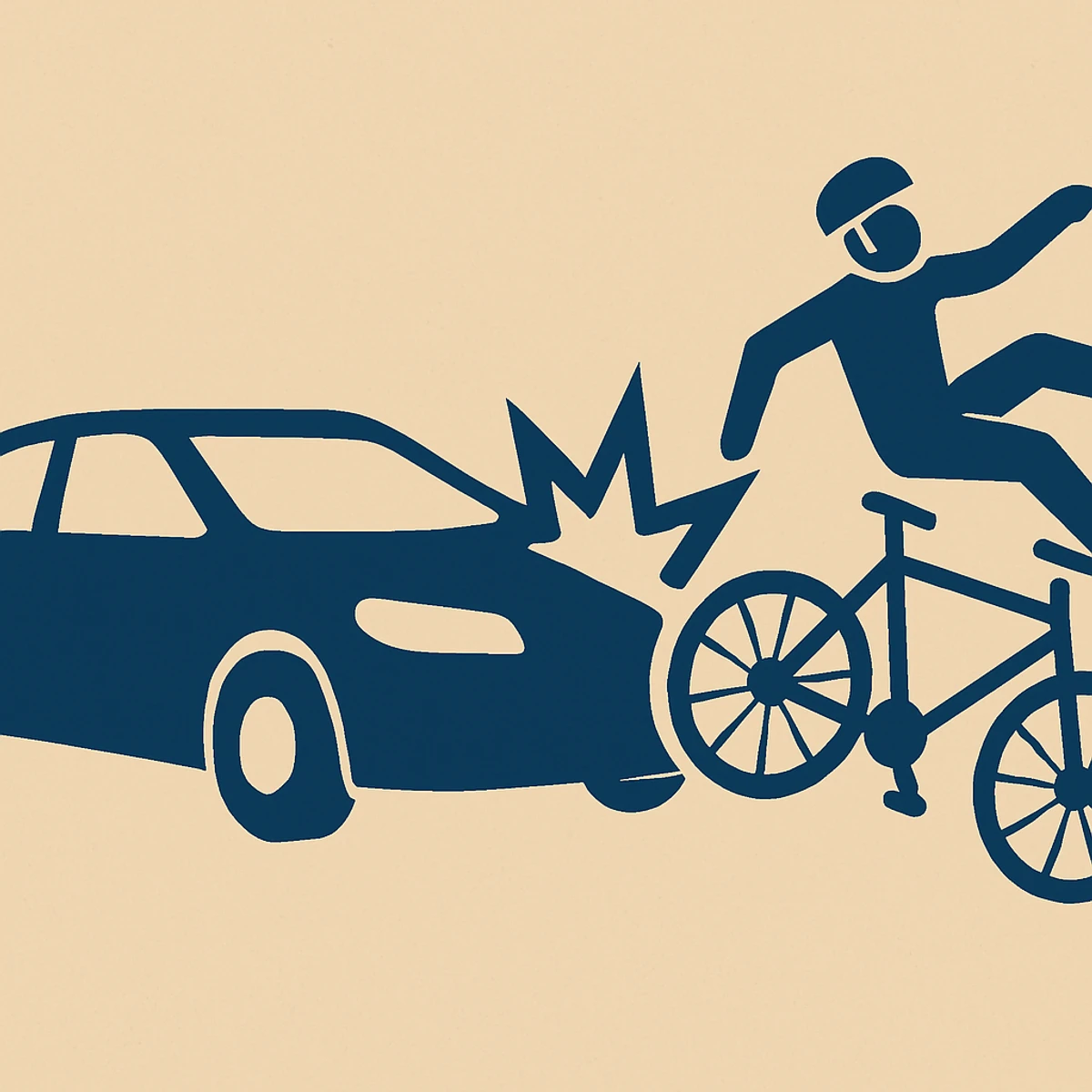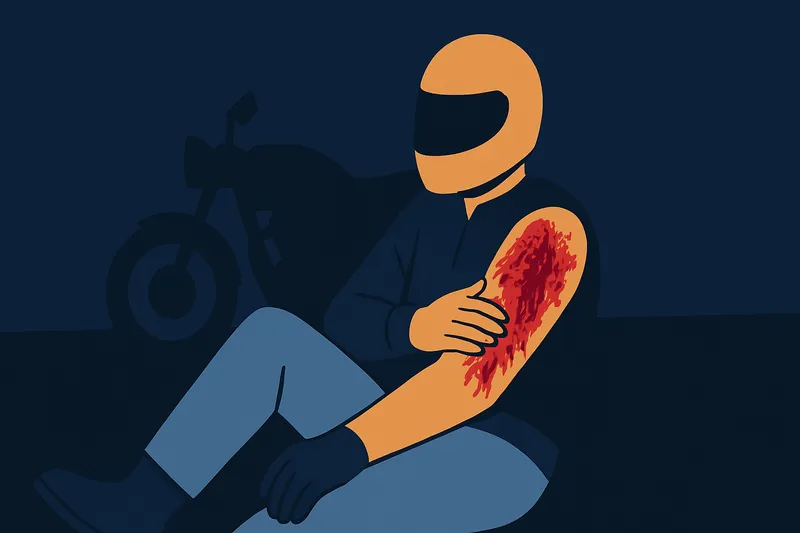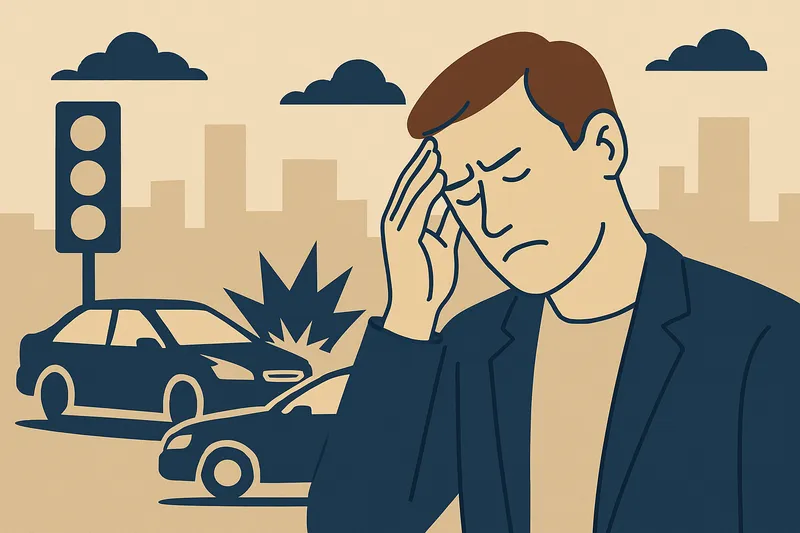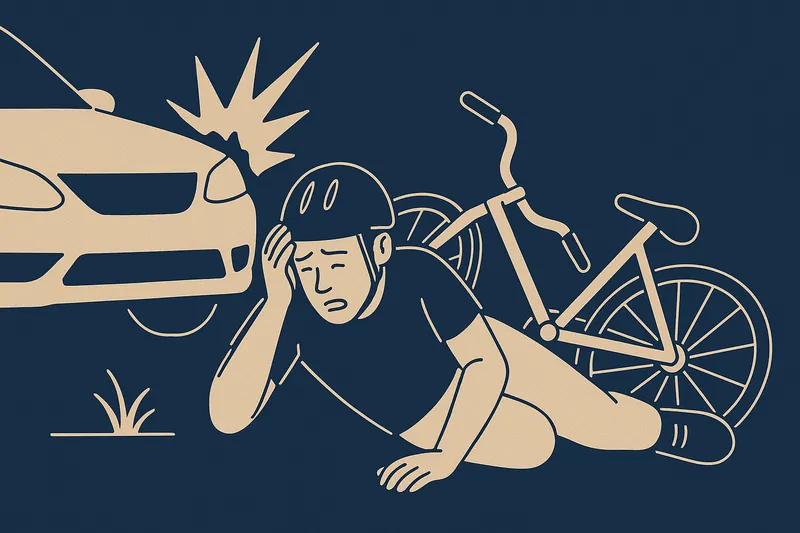Does Auto Insurance Cover Bicycle Accidents in Georgia?

Published: 3/24/2025
Yes – auto insurance often covers bicycle accidents in Georgia, depending on who was at fault and what coverages are in place. Georgia is an “at-fault” state for auto accidents. This means the insurance of the driver who caused the crash typically pays for the damages. Below, we break down how Georgia auto insurance may cover a bicycle accident in different situations and explain the various types of coverage (liability, MedPay, UM/UIM, etc.) that might help an injured bicyclist.
When a Motorist Hits a Bicyclist (Driver At Fault)
If you were riding a bike and a car hit you due to the driver’s negligence, the law treats it similarly to a regular car accident. The at-fault driver’s auto insurance should cover your injuries and bike damage.
Georgia drivers are required to carry liability insurance that covers injuries to others if the driver is at fault. If a motorist strikes a bicyclist, the driver’s bodily injury liability insurance should pay for the cyclist’s medical bills, lost income, pain and suffering, and other injury-related damages (up to the policy limits). For example, Georgia law requires at least $25,000 in bodily injury coverage per person (up to $50,000 per accident). This minimum could cover a bicyclist’s emergency treatment and some additional care. Keep in mind that bicycle injuries are often severe, and the driver’s minimum coverage might not be enough to fully compensate you.
The at-fault driver’s **liability insurance **also must cover damage to your property caused by the crash. This includes the cost to repair or replace your bicycle, helmet, and any other personal property (like a phone or backpack) damaged in the accident. Georgia drivers must carry at least $25,000 in property damage liability coverage. For instance, if your bike was wrecked by the collision, the driver’s insurance should pay for the bike’s repair or its value (up to the coverage limit).
Uninsured/Underinsured Motorist (UM/UIM) Coverage is optional coverage you can purchase on your own auto policy to protect you if the at-fault driver has no insurance or not enough insurance. In Georgia, UM/UIM coverage will cover you even if you weren’t in a car – for example, if you are hit by a car while cycling or walking. If the driver who hit you is uninsured or flees the scene (hit-and-run), your UM coverage can step in and pay for your injuries just as if it were the at-fault driver’s liability insurance. If the driver has some insurance but not enough to cover all your medical costs and losses, your underinsured motorist coverage can pay the difference up to your policy’s limit. For example, if the driver only has $25,000 of coverage but your damages are $50,000, your UM policy (if you have one) could cover the remaining $25,000. In Georgia, insurers must offer UM coverage, but you have to opt in (it’s not mandatory). Also, if you don’t have a car or auto policy of your own, you might still be covered under a resident relative’s auto policy UM coverage (for instance, a spouse or parent’s policy) if you live in their household. UM coverage can cover bodily injuries, and in some cases property damage to your bike if you have a UM property damage provision – check your policy for details.
Medical Payments Coverage (MedPay) is optional first-party coverage on Georgia auto policies that pays for medical expenses regardless of who was at fault. If you have MedPay on your car insurance, it can cover your medical bills if you’re injured in a bicycle accident with a vehicle even if you were not driving a car at the time. In other words, you as an insured person are covered as a cyclist or pedestrian hit by a motor vehicle. MedPay will pay for reasonable and necessary medical costs (doctor bills, hospital stays, ambulance, etc.) up to the coverage limit you chose (common limits might be $1,000, $5,000, $10,000, etc.), no matter who caused the accident. This can provide quick help with medical bills while fault is still being sorted out. For example, if you have $5,000 MedPay coverage, it could pay your $5,000 hospital bill right away, even while you pursue a liability claim against the driver. Georgia does not require MedPay, but many drivers carry it for added protection. If you live with family, a household member’s MedPay coverage may also cover you as a resident relative. Remember, MedPay is in addition to any liability claim – you can use MedPay and still later collect from the at-fault driver’s insurance for other damages. (MedPay may seek reimbursement from any liability settlement, but that’s a behind-the-scenes issue.)
Personal Injury Protection (PIP) is a no-fault insurance coverage required in some states, but Georgia is not a no-fault state, so PIP is not required here. Georgia drivers typically do not have PIP unless they purchased it separately or moved from a state that requires it. However, PIP functions similarly to MedPay by covering your medical costs (and sometimes lost wages) regardless of fault. If by chance you do have PIP coverage (or if the driver who hit you has PIP from another state), it could cover a bicyclist’s injury expenses as well. In practice, for Georgia residents, MedPay coverage fills this role of optional no-fault medical coverage. So if you see “PIP” in your policy, treat it like MedPay. Just remember that neither PIP nor MedPay is automatically included in Georgia – you must have added it to your policy for it to apply.
Bottom line
When a driver is at fault, their insurance should pay for an injured bicyclist’s damages. You may claim against the driver’s bodily injury liability for your injuries and property damage liability for your bike/gear. If the driver has no insurance or not enough, your own UM/UIM coverage (or a family member’s policy) can cover your medical costs and even property damage in some cases. And regardless of fault, your MedPay coverage (if you have it) can help pay medical bills immediately. This multi-layered approach ensures you have several potential sources of recovery after a bicycle accident caused by a motor vehicle.
Driver’s Liability Insurance Won’t Cover Your Injuries if You’re At Fault
Liability coverage only pays out to people injured by the policyholder’s negligence. So if the motorist did not cause the crash, their insurance is not obligated to pay an at-fault cyclist for injuries. You generally cannot make a liability claim against the driver’s policy if you were solely or mostly to blame. In this scenario, the costs of your injuries would need to be covered by other means – for instance, your own health insurance or out-of-pocket, and potentially your MedPay coverage if you have it (MedPay will pay even if you caused the accident, since it doesn’t depend on fault). The driver’s insurance would only cover your injuries if the driver was at least partly negligent. Georgia follows a modified comparative negligence rule: if the cyclist is less than 50% at fault, they can still recover some damages from the driver’s insurance, reduced in proportion to their share of fault. But if the cyclist is 50% or more at fault, they cannot recover from the other driver’s liability coverage at all. For example, if a car and bike crash and you are found 30% responsible and the driver 70% responsible, you could collect 70% of your damages from the driver’s insurer. If you were 51% at fault, you’d be barred from recovering from the driver. This rule encourages safe cycling and driving – each party’s insurance only pays if that party was mostly at fault.
Your Auto Insurance Liability Coverage Won’t Cover the Accident Either
It surprises some cyclists to learn that your own auto liability insurance does not cover accidents when you’re on your bicycle. Auto liability coverage follows your vehicle; it covers you when you are driving your insured car and cause harm to others. A bicycle is not a covered automobile under a standard auto policy. So if you, as a cyclist, injure someone or damage someone’s car, your auto policy’s liability section won’t apply (because you weren’t operating your car in the accident). In other words, the driver can’t file a claim against your auto insurance for the damage you caused with a bike. Instead, the driver’s collision coverage (if they have it) might pay for their own car repairs, or the driver might seek payment from you personally for the damages. Many cyclists in this situation turn to their homeowner’s or renter’s insurance for liability coverage – most homeowner/renter policies include personal liability coverage that can cover accidental injuries or property damage you cause, including accidents involving non-motorized vehicles like bicycles. For example, if you accidentally ride into someone’s parked car and scratch it, your homeowner’s insurance (if you have one) could pay for the repairs to the car. This is not “auto” insurance, but it’s a relevant coverage when auto insurance doesn’t apply to the bicyclist’s liability.
Collision and Comprehensive Coverage
These cover damage to your own vehicle. While they don’t directly apply to a bicycle (since a bicycle is not your insured vehicle under an auto policy), these coverages could indirectly come into play in a car-bike incident. For instance, if a cyclist caused an accident that damaged your car, your collision coverage could pay for your car repairs (you’d then potentially seek reimbursement from the cyclist). From the cyclist’s perspective, collision/comprehensive on their auto policy won’t cover a bicycle, but some cyclist might have specialty insurance or homeowner’s coverage that covers their bike for theft or damage. Typically, auto comprehensive covers your car from non-collision damage (theft, fire, etc.), and wouldn’t involve a bicycle accident unless perhaps your bike was on a rack on your car during an incident (a very specific scenario). For most injured cyclists, collision/comprehensive is not directly relevant except if a car was also damaged.
Household Insurance Coordination
It’s worth re-emphasizing that if you don’t own a car and thus have no auto policy, you still might not be completely without coverage. If you live with relatives or a spouse who has auto insurance, you may be covered by certain coverages on their policy (like UM or MedPay, as noted) as a household member. Always inform your family member’s insurer that you were involved in an accident as a cyclist – they can tell you if any of their coverages apply to you. This is especially important for students, minors, or others in a household who bicycle regularly but don’t carry their own auto insurance. Additionally, your health insurance (though not auto insurance) is a crucial resource to cover treatment costs initially if you’re injured. Georgia law allows the health insurer to be reimbursed if you later get a liability settlement, but don’t delay treatment because of costs – use MedPay or health insurance to get treated, then sort out reimbursement after you’re safe.
Key Georgia Laws and Considerations
Minimum Insurance Requirements: As mentioned, Georgia drivers must have at least 25/50/25 in liability coverage. These minimums apply to accidents involving bicyclists just as they would for car occupants – the insurance is meant to cover any person the insured harms in a crash, including a cyclist or pedestrian. However, minimum limits are often not enough for serious bike injuries. It’s perfectly legal for drivers to carry higher limits, and many do. An injury victim can claim up to the policy’s limit; if damages exceed that, you may need to use UM coverage or consider legal action for the remainder.
Comparative Negligence in Georgia: Georgia law follows a 50% bar rule for comparative negligence. If you (the injured bicyclist) are 50% or more at fault, you cannot recover injury compensation from the other party. If you are 49% or less at fault, you can recover, but your award is reduced by your percentage of fault. This affects how insurance claims are handled. Insurance adjusters will look at evidence (police reports, witness statements) to decide if the bicyclist contributed to the accident (for example, not obeying traffic signals or riding unpredictably). If they believe you were largely at fault, they may deny your claim. If fault is shared, they might offer a reduced settlement. It’s important for victims to know that being partially at fault doesn’t automatically bar you from recovery, as long as you were less at fault than the driver. Don’t assume you have no case if you think you did something wrong; the driver might still bear greater blame.
No-Fault vs. At-Fault: Unlike some states, Georgia does not have a no-fault auto insurance system. There is no automatic PIP coverage that pays everyone’s injuries regardless of fault. Instead, fault matters for whose insurance pays. This is why establishing fault (through a police report, witness accounts, possibly accident reconstruction) is critical in a bike accident. Always call the police after a car-bike collision, so there is an official report. That report will be very useful when filing claims to show who was at fault. Also, Georgia law requires drivers to stop and render aid when involved in an accident – if a driver hits you and leaves (hit-and-run), they are violating the law. In hit-and-run cases, since you can’t go after the missing driver’s liability insurance, you would use your UM coverage as discussed.
Accessing Coverage Through Different Policies: Don’t forget that multiple insurance policies might be involved in one bicycle accident. You might be dealing with the driver’s insurance for liability, your own auto insurance for UM or MedPay, and even a family member’s policy if applicable. These claims can run in parallel. For example, you could simultaneously file a liability claim against the driver and a MedPay claim with your insurer. This is generally acceptable and even expected. Just be sure to keep good records of all claim numbers and contacts. When dealing with the other driver’s insurer, stick to the facts of what happened; when dealing with your own insurer for first-party benefits, provide the necessary medical information promptly. Georgia law prohibits insurers from raising your auto rates for making a UM claim when the accident wasn’t your fault (since UM claims mean someone else caused the damage). Using MedPay also typically does not penalize you. So do not hesitate to use the coverages available to you – that’s why you have insurance.
Conclusion
In Georgia, if you’re injured in a bicycle accident involving a motor vehicle, auto insurance can indeed cover the incident – it just depends on the circumstances.
Remember, insurance is there to protect people in exactly these situations. If you’re an injured cyclist, know your options. The driver’s policy, your own auto policy, and even policies of family members could all provide coverage to help you recover physically and financially after a bicycle accident. Georgia law supports your right to compensation when a motorist is responsible, and even gives you backup options like UM coverage when they are not insured. By understanding the coverages – bodily injury liability, property damage, MedPay, UM/UIM, and more – you can navigate the aftermath of a bicycle crash with more confidence and ensure you utilize all sources of insurance available to you. Stay safe, and don’t hesitate to file claims for the coverage you’re entitled to under Georgia law if you find yourself the victim of a bike-vehicle accident.
Related Articles



